
As with implementing any change, the effectiveness of the process depends on the amount of acceptance and ownership that the proposed changes enjoy. Youth leaders should talk about commitment level youth ministry with the group leaders before they think of making changes. Then they should involve the leadership team in the following process to implement the model.
Three aspects of implementation of the commitment level model will be considered:
1. Implementation in a Youth Group
2. Implementation in a Youth Ministry
3. Implementation in Stages
1. Implementation in a Youth Group
A. Discover Who Attends the Group
The first step in developing commitment level youth ministry involves identifying the different categories of young people who attend the youth group. The kinds of youth who would be identified include: unchurched, non-believers, seekers, converts, disciples, leaders, etc.

Follow this link to view a full page graphic to print and use in the implementation process.
B. Identify Youth Commitment Levels
The next stage involves getting an idea of where the young people are spiritually, by attempting to place each of the young people at one of the six levels of commitment. This will give a guideline as to where the concentration of youth lie, and reveal areas of weakness. This is not a simple process and the end result should be regarded as a guideline. Leaders will find that some youth fall between the levels - in fact it is best to think in terms of a sliding scale or continuum. The names of youth should be filled in on the following chart:
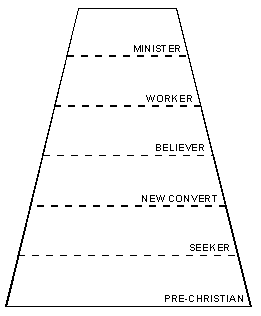
Follow this link to view a full page graphic to print and use in the implementation process.
C. Evaluate Ministries at Each Level
The funnel diagram is helpful as the youth pastor evaluates what programmes the group has at the various levels of commitment. This step will show if the group is presenting too many programmes at a certain level or which levels are being neglected. Leaders should also ensure that the programmes are aimed correctly by evaluating the commitment level of those attending the event and at which level it is actually targeted. For example, a seeker event must be aimed at the unchurched person, so it would probably not be a Bible study which might be appropriate at a believer or worker event. List all the events that the group has on the following chart:
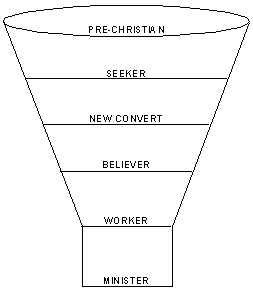
Follow this link to view a full page graphic to print and use in the implementation process.
D. Adjust Programmes as Necessary
The group should end programmes that are unnecessary, adjust those that need changing and begin new programmes at commitment levels that the group is not touching at present. However, do not start too many programmes simultaneously. Be bold, but realistic, in strategising for the future. Implementation should proceed slowly to ensure that present leaders are not left behind. The group could start with three levels of ministry, ie. a Rave Event to evangelise youth who attend the group; a Follow-up Event to follow up new converts and a Believer Event to grow Christian youth spiritually. Then a Contact Event could be added where the group goes onto the turf of unchurched youth and then a Ministry Event to help youth discover their spiritual gifts. Finally the group could add a Worker Event where Christian youth are involved in a service project or short-term mission trip.
E. Draw a Funnel of All Ministries
Draw a diagram that places all the programmes in sequence as a funnel - moving from humanity events at the widest part to multiply level events at the narrowest section.

Follow this link to view a full page graphic to print and use in the implementation process.
F. Develop the Model Further
The following suggestions involve developing the model in the life of the local church:
(1) Develop a council to coordinate youth ministry. This is a group of representatives from each of the three age group ministries (children, teenage and young adult) under the oversight of a youth pastor, or youth ministry coordinator. The council would also include any youth specialists within the church, such as social workers, counsellors, parents and concerned adults. It should include representatives from all ministries that affect youth, including Sunday School. The functions of the youth council are: (a) ensure a smooth transition between the age groups, (b) provide a unified sense of purpose and direction regarding focus and curriculum, (c) organise combined events that bring the different groups together, and (d) share resource between the groups.
(2) Involve leaders in the younger age group. Disciple, develop or multiply level teenagers can be involved in the leadership of the children's group according to their spiritual maturity and gifting. The same applies with young adults working as leaders in the teenage group alongside teenage leaders. This implies that middle-aged adults should be involved in the young adult group. In fact, each generation should be reaching back to pass on what they have learned to the generation following behind them.
(3) Extend the commitment model of ministry to the whole church. The whole church should be run with a commitment level ministry philosophy. Each age-sepecific ministry must be encouraged to adapt their programmes to meet people at each commitment level. For more information on points (1) to (3) see the leadership page.
(4) Ensure that all ministries are relational. The key to effective youth ministry is relationships with youth. Significant ministry occurs as leaders lives impact the lives of youth. Events must include time for relationship building before, during and after the programme.
2. Implementation in a Youth Ministry
Youth ministry within an established local church is often fragmented and uncoordinated. In
many churches various groups exist that target the same group of people, without any contact
taking place among the leaders of those groups. For instance, in children's ministry, a church
could have different departments, ie. Sunday School, a Friday night group, after care ministry, contact with a Christian school, holiday clubs, camps, etc. This results in ministries that run alongside each other and maybe even in opposition to each other.
If a facilitator follows the standard process for implementing the commitment level model of
youth ministry there is a real danger that the ministry will become even more uncoordinated as each
department tries to develop events to target ministry at each level of commitment. It is more important for groups within each age group to determine how they can work together to establish age-based ministry as opposed to department-based ministry.
The implementation process for the model involves the following steps: (1) Discover who
attends the group (identify the different categories of young people who attend the group); (2) Identify commitment levels (identify where each of the young people are at according to the six levels of commitment); (3) Evaluate ministries at each level (list all the programmes the group has at the various levels of commitment); (4) Adjust programmes as necessary (end programmes that are unnecessary, adjust those that need changing and begin new programmes at commitment levels that the group is not touching at present); (5) Draw a funnel of all ministries (draw a diagram to place all the programmes in sequence as a funnel); (6) Develop the model further (develop a youth council to coordinate youth ministry, involve leaders in the younger age group, extend the commitment model of ministry to the whole church, and ensure that all ministries are relational).
During the implementation process the facilitator should place the representatives from the
various ministries into age-specific groups (ie. all the children's ministry workers in one group) and have them complete Steps 1 to 3. Then, before moving on to step 4, they should show how the different ministries within each age group (ie. Friday group and Sunday School), should or could be working together more effectively. The one group may be more focussed at the Come and Grow Levels while the other more focussed at the Disciple and Develop Level. Neither may be touching the Humanity or Multiply Level which other ministries may be covering.
A funnel should be completed for each age group, ie. children, teenages and young adults, that identified the commitment level at which each department targets their ministry. Each department should focus on their primary ministry purpose and place themselves on the funnel accordingly. This will show graphically how the various departments work together in providing ministry at each level of commitment. This process will reveal the areas that overlap in ministry and areas that are neglected. They should then as an age group work through the rest of the steps (ie. step 4 to 6). This process will ensure greater cooperation between the groups and allow each group to fulfil their unique role in commitment level ministry.
Where a church has a number of departments within each age group, they should establish a leadership team for each age group. The role of the leadership team is to oversee the movement of youth through the various commitment levels and to co-ordinate the events or ministries at each commitment level. It would be ideal to assign one or two representatives from each ministry department to the age-based leadership team.
The establishment of a Youth Council, referred to under Step 6, is essential in order to ensure
that the various groups develop youth through the full spectrum of commitment levels, handle
transitions between the groups effectively, share resource and work together. One or two representatives from each age-specific ministry is invited onto the Youth Council in order to oversee the whole range of youth ministry and the progression of youth from one age group to the next.
The following diagram shows how the departments, age-based leadership teams and Youth Council operate together:
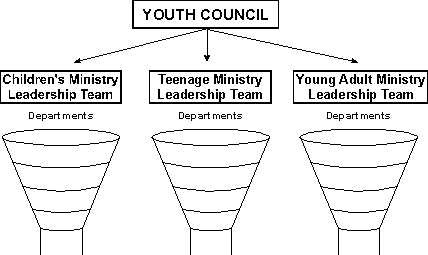
It must be said that implemention of the model, including starting new ministries at various commitment levels or in specific age group, should take place over a period of time. Ministries should be added as leaders are developed and under the prompting of the Holy Spirit.
In new churches the leadership may wish to slowly add ministries at each age group as they follow ministry though with one age group. The Windsor Fellowship church grew in this way. A children's ministry was started and after a few years when these children were entering high school a teenage ministry was started. When the teenagers began graduating from high school it was time to start a ministry among young adults. In fact it was only around this time that the first Sunday worship services were started.
In established churches there will probably already be ministries at each age level, but as the process mentioned above is completed the temptation may be to commence new ministries simultaneously. This would be unwise and could result in ministries that do not last for long, or which never get off the ground. It is best to prioritise ministries and implement them as and when appropriate.
3. Implementation in Stages
For many youth groups the six level ministry example of the Windor Fellowship may be too adventurous to tack initially. The Windsor group implemented the model in a number of stages:
A. The Two Event Strategy - At first the youth group presented Rave programmes (organised by a rave committee that included a number of unchurched youth), which were fun activities, such as an evening at a pizza restaurant. It was designed to encourage youth to bring friends and get to know others in the group. The group also had Spiritual programmes that focussed on helping Christian youth to follow Christ. One term taught youth how to discern the messages they were getting from music, advertising and films. While the one event was visitor-orientated and the other believer-orientated, the transition between them was not effective.
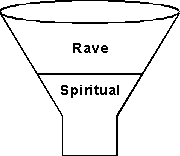
B. The Four Event Strategy - The second stage in the group's programming development involved the addition of two further events. The Rave Event continued, but was moved to a Saturday, ie. a fun outing at a swimming pool. The Discovery Event took over the Friday evening meeting where, in the context of games, activities, discussion and a short devotion, youth were introduced to the group and to Christ. The Growth Group met before the discovery event where youth learned more about the Bible and Christianity. Finally, Impact Events were held which involved Christian youth in the group reaching into the community, ie. old age homes, hospitals, holiday clubs, etc. This strategy was an improvement, but the discovery event needed to be developed to assimilate unchurched youth and two others areas (follow-up and leadership development) were still lacking.
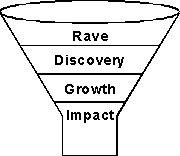
C. The Six Event Strategy - The third stage in the group's programming development involved the following events: A Contact Event - aimed at reaching unchurched youth in the community through sports events (this replaced the previous rave event). The Rave Event replaced the discovery event - with a four-week programming strategy aimed at reaching and integrating youth into the group. A Follow-up Event in the form of a four to six week discipleship course for new converts was started. The Growth Event continued, but was moved to a Sunday afternoon. The Impact Event is a service-orientated programme in a children's home that is run monthly on a Saturday afternoon. A final event is the Leader Event where at each term's planning session a time of leadership development is included to train youth for ministry responsibility. Note: This level was later changed to Ministry which ensures that all youth are involved in ministry.
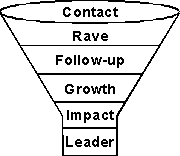
While the progression in the preceding section may give the impression that the Windsor youth group has found the best strategy (ie. the six event strategy), this is not the case.
The group is continually revising their programming strategy and do not feel that they have
arrived at THE definitive strategy. In fact, it is highly probably that each youth group will find a
strategy that is appropriate to their context, and with which they are most comfortable. Youth
groups should evaluate where they are in terms of the stages in programming mentioned above
and begin to work through the process, rather than jumping to the final strategy. For a youth
group with one event during which all the levels are targeted, the best approach would be to add
one new event and get it up and running, before adding another. They should run with two events
for a while, ie. targeting the come and disciple levels. When this stage is reached they could add a
third event to help with the transition, ie. an evangelistic event.
The student ministry department at Willow Creek Community Church focuses on three commitment levels: seeker; believer and leader (Student Ministry for the 21st Century by Bo Boshers, Zondervan, 1997).
Read an Insider's Perspective on ministry organisation at Windsor.
Read about Managing Change in Implementing the Model
Read about Managing Conflict in Implementing the Model
Return to Model of Youth Ministry